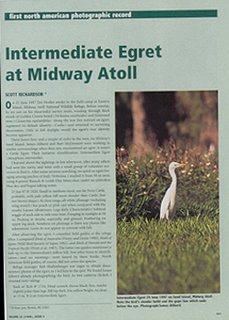
I've just found the Editors' Notebook from a 2004 issue of North American Birds, where Edward S. Brinkley writes:
We intend to revisit an older article on Intermediate Egret on Midway Atoll, Hawaii (N. A. B. 53: 441-443), which may pertain to an "Eastern Cattle-Egret" rather than an Intermediate Egret (have we piqued the reader's interest?).
As the author of the article in question, I am eager to see the clarification, which is apparently approaching a draft stage now. Ever since I was informed that the American Ornithologists' Union check-list committee passed over the "intermediate" egret report in its 45th supplement, I have hoped to read a well documented alternative view. I expect to be presumed mistaken and am comfortable with that. It's just hard to be wrong so publicly.
It happens, though; I am not alone. After recounting a handful of other questioned identifications recorded in NAB, Brinkley goes on to write:
It is remarkable, and very humbling to one's own grasp of bird identification, to receive opposing opinions from experts in their fields!
Comments